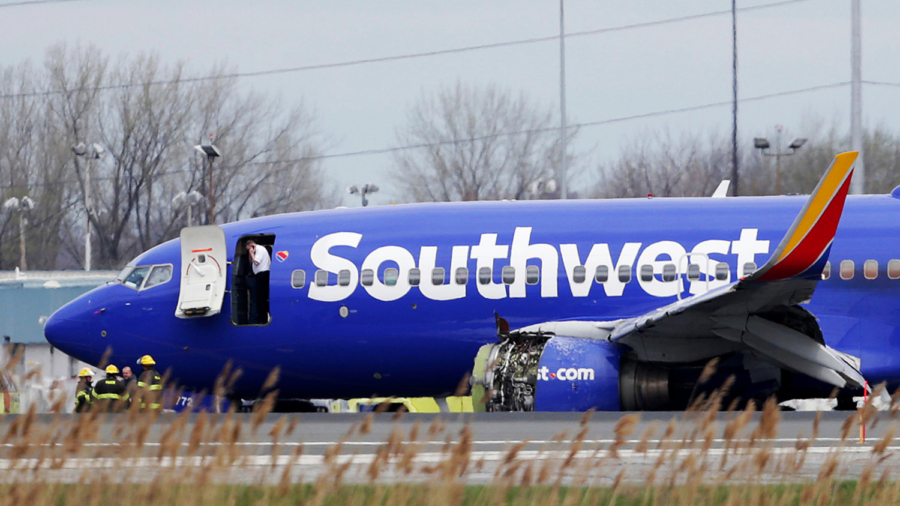A Southwest flight had to turn around and make an emergency landing after a loss of cabin pressure caused passengers ear pain and, according to local media, left one with their ears bleeding.
The Feb. 1 night flight to Tampa, Florida, turned back to Hartford in Connecticut only a half hour into the three-hour journey, reported the Hartford Courant.
There was no indication of severe injuries, according to the Courant, but ambulances were dispatched for several passengers who experienced ear pain and injuries.

The pilot of the Boeing 737 asked for emergency medical technicians to meet the flight, and initial reports were that at least one passenger had bleeding ears.
“The pilot declared an emergency and reported a possible pressurization issue,” an FAA spokesman said on Feb. 1, according to the Courant.
Flight 1694 got as far as eastern New York state, before circling back round to Bradley airport in Connecticut, where it had taken off an hour earlier.
“Several customers among the 139 on board are being treated for injuries and discomfort by local paramedics,” Southwest said in a written statement, reported the Courant. “We have removed the aircraft from service and will accommodate those wishing to continue their travel with another aircraft.”
Blood in Oxygen Mask
Bleeding from the ears is a common occurrence in the event of depressurization.
Last September, pilots of a Jet Airways flight reportedly “forgot” to turn on a cabin pressure switch and had to make an emergency return to the airport after passengers started to bleed from their noses and ears.
The Boeing 737 aircraft, which was carrying 166 passengers, landed safely. At least 30 passengers suffered ear and nose bleeds, NDTV reported on Sept. 20, 2018.
Passengers on board Jet Airways flight 9W 697 from Mumbai to Jaipur captured video of the incident, showing frantic passengers and oxygen masks dangling from the ceiling.

An Indian security official looks on as an aircraft of Jet Airways taxies at Indira Gandhi International Airport in New Delhi on Sept. 12, 2012. (Raveendran/AFP/Getty Images)An official with the Directorate General of Civil Aviation (DGCA) said that the crew forgot to press a button to pressurize the cabin, according to News 18. “During the climb, the crew forgot to select the bleed switch due to which cabin pressurization could not be maintained, and oxygen masks got deployed,” the official said.
Panic situation due to technical fault in @jetairways 9W 0697 going from Mumbai to Jaipur. Flt return back to Mumbai after 45 mts. All passengers are safe including me. pic.twitter.com/lnOaFbcaps
— Darshak Hathi (@DarshakHathi) September 20, 2018
A Ryanair flight was diverted in July after depressurization that caused 33 passengers to be treated in hospital, with some bleeding from the ears.
One photograph circulated on social media, reportedly taken by a passenger on the flight, showed an oxygen mask with blood in it.
‘The Packet of Chips Would Also Explode’
According to Adam Taylor, Director of the Clinical Anatomy, a sudden change in pressure could have caused the small blood vessels in the roof of the nose to rupture, due to expanding liquids and gases in the tissues and blood.
“For comfort and safety, aircraft cabins are ‘pressurized’ to an altitude of somewhere between 5,000-8,000 feet, which is lower than pressure at sea level,” wrote Taylor in an analysis of the incident. “This is why if you take a bag of crisps on the flight, it looks like it is about to burst.”
While #Ryanair claimed "a small number received medical attention as a precaution", a total of 33 passengers, some of who were bleeding from their ears and nose, had to be hospitalised. https://t.co/mM58hlDWkJ
— Latest on SAYS (@saysdotcom) July 15, 2018
When the cabin pressure drops, higher pressure air is trapped inside the ears like the air in the bag of chips. This can be released by sucking sweets, drinking, and yawning, which opens up the Eustachian tube that runs from the middle ear to the back of the nose, allowing air to move through and pressure to equalize.
But the pressure outside the aircraft is still much lower—around only one third the pressure at sea level.
In the event of a loss of cabin pressure, the air escapes to outside the aircraft, and the pressure drops.
The same happens inside the passenger’s ears.
Taylor said, “At this high altitude, the pressure difference may result in ‘barotrauma,’ rupturing the eardrum and small blood vessels in the ear, causing hearing problems and bleeding. At this point, the packet of crisps [chips] would also explode.”
Tom Ozimek contributed to this Report


